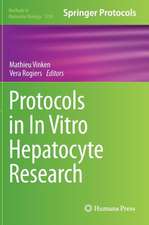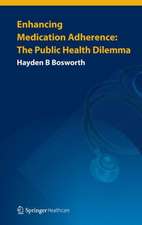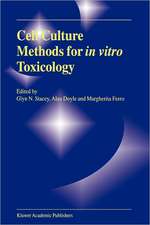Biochemical Pharmacology as an Approach to Gastrointestinal Disorders: Basic Science to Clinical Perspectives (1996)
Editat de Timothy S. Gaginella, K. D. Rainsford, Gyula Mózsiken Limba Engleză Paperback – 9 noi 2012
Preț: 377.52 lei
Preț vechi: 397.38 lei
-5% Nou
Puncte Express: 566
Preț estimativ în valută:
72.26€ • 78.52$ • 60.74£
72.26€ • 78.52$ • 60.74£
Carte tipărită la comandă
Livrare economică 21 aprilie-05 mai
Preluare comenzi: 021 569.72.76
Specificații
ISBN-13: 9789401062671
ISBN-10: 9401062676
Pagini: 412
Ilustrații: X, 396 p.
Dimensiuni: 160 x 240 x 22 mm
Greutate: 0.64 kg
Ediția:Softcover reprint of the original 1st ed. 1997
Editura: SPRINGER NETHERLANDS
Colecția Springer
Locul publicării:Dordrecht, Netherlands
ISBN-10: 9401062676
Pagini: 412
Ilustrații: X, 396 p.
Dimensiuni: 160 x 240 x 22 mm
Greutate: 0.64 kg
Ediția:Softcover reprint of the original 1st ed. 1997
Editura: SPRINGER NETHERLANDS
Colecția Springer
Locul publicării:Dordrecht, Netherlands
Public țintă
ResearchCuprins
Introduction: Advances in the biochemical pharmacology of gastrointestinal (GI) functions as an approach to understanding GI disorders.- I. Gastrointestinal Secretory and Excretory Functions.- Possible compensation in epidermal growth factor production by saliva in rat.- Regulatory mechanism of acid secretion in rat stomach after damage — role of nitric oxide, histamine and sensory neurons.- Secretory pathways in histamine-containing enterochromaffin-like cells of rat stomach.- Nitric oxide as a modulator of fluid absorption in rat jejunum in vivo.- Mechanism of cholera.- Critical evaluation of acinar, ductal, vascular and intestinal intraluminal factors influencing pancreatic cytoprotection.- Peptide receptor antagonists and monoclonal antibodies raised against peptides: tools to study physiological regulation of pancreatic function.- Mechanisms and regulation of Cl- secretion in the large intestine: studies with the rat distal colon.- II. Gastrointestinal Motility.- Prostaglandin E2: actions on the circular and longitudinal contractions of the canine colon.- Gastric motor effects of endothelins in the lower brainstem of the rat.- Effects of erythromycin on the propulsive motility of upper gastrointestinal tract in rats.- Bicuculline blocks the inhibitory effects of substance P but not vasoactive intestinal polypeptide on gastric motor function in the nucleus raphe obscurus of the rat.- Pathological basis and clinical aspects of oesophageal motor disorders.- III–IV. Biochemical—Pharmacological Mechanisms in Neural and Hormonal Normal and Pathological Reactions Involved in GI Functions.- Distribution of muscarinic receptor mRNAs in the stomach of normal or immobilized rats.- Changes of sensory neuropeptides in experimental gastrointestinal diseases.- V. GI MucosalInjury and Protection.- Biochemical energetical backgrounds and their regulation in the gastric corpus mucosa in patients with different gastric secretory responses.- Oxidative stress and its prevention in toxic liver lesions. An overview.- The effect of drugs on liver function and biliary secretion.- Alteration of microvascular regeneration and permeability during acetic acid-induced gastric ulcer healing: effect of basic fibroblast growth factor.- Modulation of gastric wound repair by hepatocyte growth factor and basic fibroblast growth factor.- The effect of resiniferatoxin on experimental gastric ulcer in rats.- AIDS treatment and the heat shock protein level in the gastrointestinal tract.- ELISA and Western blot studies with basic fibroblast growth factor (bFGF) and platelet-derived growth factor (PDGF) in experimental duodenal ulceration and healing.- Biological oxidants as intestinal secretagogues.- A new uniform biochemical explanation for the development and location of ‘genuine’ gastric, duodenal and jejunal ulcers in patients.- VI. Molecular Mechanisms of Premalignant and Malignant Diseases in GI Tract.- Current problems and results of tumour immunology: diagnostic and therapeutic relevance of tumour-associated antigens.- VII. Use of Isolated Cells and Cell Cultures in Biochemical Pharmacological Studies to Approach GI Diseases.- Does omeprazole-induced hypergastrinaemia contribute to the enhanced healing of acetic acid-induced gastric ulcers in rats?.- Modification of pathobiological events by potential hepatopharmacological agents.- Organoprotection and cytoprotection of histamine differ in rats.- Comparative viability studies on isolated gastric mucosal mixed cells and hepatoma and myeloma cell lines with ethanol, indomethacin and their combination.








